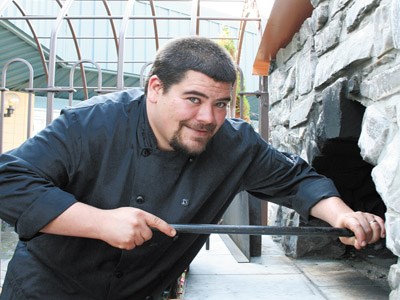Ristorante Verdicchio is bringing a bit of the Old World to Greater Sudbury.
Central Italian cuisine is its forte, with an emphasis on tried-and-true recipes from the past, along with new creations, said the owners and staff.
The restaurant, owned by the Gregorini family, has a very old book of recipes.
“Many of our recipes are from traditional regional family recipes in central Italy.
“Our family goes back generations,” said Willie Gregorini. The former teacher said the family has been in Sudbury since 1960. The restaurant has been in business for 15 years and is located at 1351-D Kelly Lake Rd. in the West End of the city.
Mark Gregorini, her son, is the present manager.
While on a trip to Italy, he said he had a chance to use his anthropology and social science research skills, honed at Laurentian University, to enhance the eatery’s menu.
“I was there for four months investigating the slow food movement and the history of food preparation in Jesi on the Adriatic coast.”
Slow food originated in Italy more than 20 years ago to counter the fast food phenomenon sweeping Europe.
Europeans, with a centuries-long tradition in exquisite food preparation, became alarmed they could loose a vital aspect of what defined themselves as Europeans.
His mother said Mark’s fact-finding trip to Italy was insightful for the restaurant.
“This is what we are trying to do, to build a relationship with the slow food movement.”
One aspect of slow food preparation is to use what foods are locally available when in season, said chef Alejandro Winzer. He is originally from Mexico and met Mark while working at a seaside resort. He has been the restaurant’s head chef for a year and brings culinary experience from his years of working in Europe and Mexico.
“We do tasting menus each week featuring a six course menu — you choose four or six items.
We feature traditional Italian cooking with local produce, as much as we can, noted Winzer.”
That can mean fresh fish from Killarney, potatoes from Chelmsford or zucchini flowers from Valley farms. When fresh strawberries were in season locally, the tasting menu reflected that fruit in its selections, from appetizers to desserts. Earlier, when local asparagus was available the menu reflected that, added Winzer.
“I bought 20 pounds of fresh asparagus from one farmer in the Valley for restaurant use.”
Blueberries, picked by the family, end up in the tasting menu as well.
Recently the tasting menu reflected what everyone has in their gardens now: zucchini.
“I stuff the zucchini flowers with fresh cheese and spices. I pan fry them. They taste really good.”
The flowers can be chopped and made into a dough with flower to make zucchini cakes. The restaurant also makes and sells its own sauce, along with a number of other condiments and preserves.
The restaurant changes its whole menu by the seasons, four times a year, to reflect the availability of produce.
Another slow food technique is to use traditional cooking methods.
Ristorante Verdicchio has had a wood-fired cook stove in the rear of the building for the past two years, said Mark.
“I got the idea while in Italy. Then I found out that a friend of mine makes the stoves.”
Winzer said the stove is the only one of its kind in the city.
“I use real wood — hardwoods and birch to bring out the flavour of the food. During the day I use it for pizzas and at night for roasts, suckling pigs, porketta and whole chicken — even a rack of lamb.”
A unique heritage method of cooking is the use of cauld fat. This is the fat off of the bottom of the animal’s stomach.
“You can only get it from certain butchers. It looks like a spiderweb,” said Winzer.
Cauld fat, when wrapped around liver, helps to keep the meat moist and tastier while it’s being cooked.
Willie Gregorini said the method was ancient.
“My grandparents and great-grandparents used it. It goes back to the medieval period in Italy.”
Cold smoking is yet another old culinary method used, said Winzer.
“Usually, when meat is smoked, the heat in the smoke does the cooking. In cold smoking there is no heat. The meat is smoked but is cooked later.” In effect, the cold smoking cures the meat and acts as a flavour enhancer.
Winzer said he buys hickory wood and wood chips.
“I also burn some spices — rosemary and bay laurel. I smoked and cooked some ribs for the Ribfest for Frank’s Restaurant.
The recession has not dampened local enthusiasm for the restaurant’s menu, said Mark.
“We are doing quite well despite the economy. Summer always has its ups and downs, what with people going to their cottages or on holidays, and the rainy weather,” he said.
“We have had good crowds this summer. I thought it would be worse. I think it helps that the city is more diversified.
“People know there are ups and downs with the mining industry so they will come out anyways.”
For more information, phone 523-2794.
Join Sudbury.com+
- Messages
- Post a Listing
- Your Listings
- Your Profile
- Your Subscriptions
- Your Likes
- Your Business
- Support Local News
- Payment History
Sudbury.com+ members
Already a +member?
Not a +member?
Sign up for a Sudbury.com+ account for instant access to upcoming contests, local offers, auctions and so much more.
